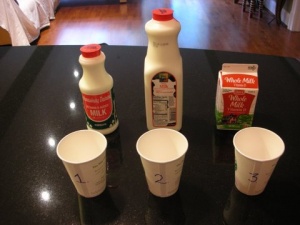June 17th, 2009 by admin in Better Health Network, Health Tips
No Comments »


I have had several people recently ask me about whether eating foods from soy is harmful. Some have asked because they have a thyroid problem and heard that soy interferes with their synthroid, others are worried about breast cancer, and most recently I guess some negative press has been writing about men and soy. Let me try to set the record straight.
What is soy?
All soy foods come from soybeans. Soy has a high protein content as well as carbs, fiber, vitamins, minerals, and some healthy fats. Soy is an excellent source of plant-based protein because it is known as a “complete protein” meaning it contains all of the essential amino acids. Whole soy is best, meaning it has been minimally processed and you are getting the naturally occurring nutrients found in the soybean. Foods that contain whole soy are edamame, soynuts, and surprisingly a bar called SOYJOY. Tofu and soymilk are also great sources of soy.
Health Benefits/Dispelling Myths
Numerous health benefits of soy have been very well documented in literature. In addition, many myths about soy have been dismissed with research studies.
Heart health: Soy is cholesterol free, low in saturated fat, and contains healthy fats. Some evidence also shows that it helps to lower LDL, or “bad” cholesterol.
Breast cancer: A high soy intake during puberty has been shown to reduce breast cancer risk, but consuming it as an adult has not been linked to lowering risk. Some animal studies have connected soy isoflavones with breast cancer growth, but no data on humans has supported this. In fact, some studies show a favorable impact on breast cancer outcomes with soy. Check with your physician before taking a soy isoflavone supplement. The American Cancer Society suggests that up to 3 servings of soyfoods per day is safe for a breast cancer survivor.
Bone health: Soybeans and calcium-fortified soyfoods are good choices because of the soy isoflavones as well as calcium and Vitamin K which can help bone mineralization.
Menopause: Over 50 studies have examined whether soy can relieve hot flashes in menopause and the consensus is that it may for many women but it depends on hot many hot flashes you get and how much soy isoflavone is taken.
Reproduction: No human data shows that consuming soy causes abnormal testosterone or estrogen levels. Several studies found no affect on sperm or semen when consuming soy isoflavones.
Thyroid: A comprehensive review of literature concluded that soy does not adversely affect thyroid function. Researchers recommended that thyroid function be reassessed if there is a large increase or decrease in soy intake, but normal day-to-day variations are unlikely to affect normal thyroid function.
Good for the Planet
Soy is environmentally friendly. The amount of fossil fuel to process soybeans is estimated to be 6-20 times less than that used to produce meat.
Bottom line
Soy foods can be part of a healthy diet for men and women. Eating 2-3 servings per day of soy foods is safe and very healthy. Soy contains important protein, amino acids, fiber, calcium, potassium, zinc, iron, and folic acid.
For more information:
www.soyconnection.com
www.soyjoy.com
This post, Is Soy Safe?, was originally published on
Healthine.com by Brian Westphal.
June 2nd, 2009 by admin in Better Health Network
No Comments »


I don’t have to tell you that in this economy everyone is looking for ways to cut costs. One place many people are choosing to save pennies is by choosing generic, or store brands, instead of name brands at the supermarket.
The Food Marketing Institute reports these stats:
- 93% of retailers plan to increase the number of store-label products in upcoming months.
- 15% of supermarket sales are store labels compared to 14% in 2008 and 11.5% in 2007.
- 10.8% increase in store label sales in most recent fiscal year. Manufactured brands grew by 2.5%.
The average family spends $98.40 weekly on groceries. If you have children, you will spend well over $100. So saving even a few dollars each shopping trip can add up.
Can you tell a difference in the store brand vs the manufactured brand? I personally will purchase store brand for many things like milk, bread, cheese, butter, etc. I have tried some of the store brand cereals and not found them to be as good as the manufactured brand. It all depends, though, on the product and the price. If a manufactured brand is on sale or if I have a coupon, it is much cheaper to go with that than the store brand.
Did you know that many of the store brands are actually made by national brands and relabeled for the store? This varies by store and product, but often those paper towels that are store brand are the same as the manufactured brand.
What do you think? What do you purchase in the generic, or store brand? Do you notice a difference?
This post, Going Generic, was originally published on
Healthine.com by Brian Westphal.
April 19th, 2009 by Dr. Val Jones in Health Policy, News
7 Comments »
I just got back from a blog workshop at the Canyon Ranch Institute in Tucson, co-led by yours truly and the lovely and charming Kerri Morrone Sparling of SixUntilMe. We had a wonderful time with the locals, acquainting them with social media terminology, and teaching them how to blog and Tweet. We were also immersed in their culture, which largely meant that I lectured (for the first time in my physician career) in yoga pants, and enjoyed small portions of food rich in fruits and vegetables.

A Javelina
Despite the arid, inhospitable environment, the Arizona desert is teeming with life. Quail, rabbits, lizards, javelinas, humming birds and woodpeckers, bob cats and coyotes – all roam around freely near adobe homes nestled between flowering cacti. The extraordinary liveliness of the desert takes the casual visitor by surprise, and the variety of scrubby plants, aloes, and cacti of every imaginable shape, size, and pricklyness is a horticulturalist’s dream.
Since I was on east coast time, I was willing to participate in the 6:30am speed walks in the desert each morning. The lovely landscape inspired reflectiveness in the walkers, though I was somewhat distracted by the roaming hoard of javelinas (very large peccaries who resemble wild boars, smell like skunks, are virtually blind, and live to eat flowering plants). The javelinas had new babies with them – described by one Canyon Rancher as “footballs with legs.”
In between workshop lectures, Kerri and I were treated to some spa services – (regular readers know that I’m a huge fan of massages) which were welcome respites from our very busy work lives. But best of all, we got to spend some time with Dr. Richard Carmona (who attended our workshop), and we discussed how social media could be the key to inspiring behavior modification in Americans who need to eat more healthily and get more exercise.
As beautiful as the Canyon Ranch is, the healthy lifestyle it promotes won’t reach beyond its own walls if they don’t engage people in ways that fit their budgets and time constraints. Now that 70% of Internet users are engaged in social media, and Facebook, Twitter, blogs, and online support groups are growing exponentially, there’s never been a better time to find ways to reach people with disease prevention messages and strategies. As Washington gears up to support preventive health initiatives as part of healthcare reform, innovative non-profits like the Canyon Ranch Institute can play an important role in helping us get America back on track in terms of weight management and fitness. Online communities like SparkPeople or the Canyon Ranch Institute could be one avenue for change.
Of course, if you can afford to vacation in Arizona, the place itself has a calming, therapeutic effect. If that’s not in the cards for you, you can still emulate the lifestyle in your own javelina-free environment. As I take my regular walks back in DC, I’ll be sure to remember those cute little footballs with legs, and wear yoga pants as often as possible during future lectures (if the NIH looks at me quizzically next month during my NLM presentation, I’ll just blame Rich Carmona).
November 29th, 2008 by Dr. Val Jones in True Stories
4 Comments »
 After my recent interview with Dr. David McCarron, I began to think of ways to increase my dairy intake. It occurred to me that I hadn’t had a glass of milk since I was a kid – sure I’d put milk on my breakfast cereal or add it to recipes, but I just never thought of it as a beverage for some reason. I bet many of you feel similarly.
After my recent interview with Dr. David McCarron, I began to think of ways to increase my dairy intake. It occurred to me that I hadn’t had a glass of milk since I was a kid – sure I’d put milk on my breakfast cereal or add it to recipes, but I just never thought of it as a beverage for some reason. I bet many of you feel similarly.
So I went to the store to get some whole milk, and I was almost overwhelmed by the options. There were many different brands (from different dairies) as well as organic options. I wondered if there was a taste difference between them. Which might be the most delicious?
I purchased three different types of whole milk: one from a local dairy, one that was organic, and a generic store brand. I brought them home and asked my husband to participate in a blind taste test. I put samples of each milk in a white, paper cup and asked him which one tasted best.
After several rounds of sipping, my husband confessed that he couldn’t tell a difference between them.
Then an unexpected thing happened. My cat wanted in on the action and jumped up on the table to participate. She had a very clear preference – she chose cup #3, the generic, non-organic store brand. Way to go, kitty – no fancy milk for you!


What’s the lesson of this totally subjective, unscientific study of n=3? Milk is good for you, it’s the best nutritional value for the cost (25 cents/cup – compare that to soda), and there’s no real taste difference between brands. Milk is a legitimate beverage – I’m going to have some more regularly… if I can wrestle it away from my cat.

November 27th, 2008 by Dr. Val Jones in Expert Interviews
2 Comments »
Happy Thanksgiving everyone – I thought I’d blog about food today, and to try to persuade you to trade that pumpkin pie for a glass of milk…
I learned some interesting things at the Dairy Science Forum on November 13th in DC. Dr. David McCarron presented some compelling data on the effects of the DASH diet on reducing blood pressure. The DASH diet is fairly high in dairy products (2-4 servings/day), fruits, and vegetables. In comparison with a low-salt diet (which reduces systolic blood pressure by an average of 1 point), the DASH diet can cause an average reduction in systolic blood pressure of ten points. If you have high blood pressure (and your kidneys are functioning normally) you probably shouldn’t worry all that much about the salt. It’s more important to stick with the DASH diet.
I interviewed Dr. McCarron about the role of dairy in blood pressure management. Here’s what he had to say:
Dr. Val: If salt isn’t the real enemy, and dairy can help to reduce blood pressure, why isn’t that message getting out?
Dr. McCarron: We have national nutrition policies in place that are old and out of date. The healthy eating paradigm – low fat, low sugar, low salt – was established 40+ years ago and when new evidence is obtained, it’s really hard to crack through that illusion of knowledge. There is excessive mistrust of new data because of the attitude that if it conflicts with our previous beliefs, it can’t be true. I believe that the Internet will be critical in allowing the evidence to bubble up. For example, a diet rich in dairy food is absolutely associated with a reduction in virtually all chronic medical conditions. We have data to support this for people of all ethnicities and from around the world. I think that consumers are looking for clarity and simplicity in their nutritional advice – and basically they need to know that a healthy diet requires 3-4 servings of dairy and 5-6 servings of fruits and vegetables/day. If you do that alone (along with regular exercise) you’ll be amazed by the results.
Dr. Val: What is the proposed mechanism by which dairy has all these positive effects?
Dr. McCarron: It’s almost impossible to nail down specific mechanisms because milk products contain so many ingredients (electrolytes, key vitamins, bioactive proteins, and essential fatty acids). Trying to understand which piece is impacting very complicated physiological control mechanisms within the body (that have 30-40 different vectors feeding into them) is extremely difficult. In fact, the permeatations make it almost impossible. We can’t come up with the proof that we do for drugs (which contain only one bioactive ingredient). What we do know, though, is that dairy is a vital component for chronic disease reduction and prevention. Unfortunately the policy people say, “you haven’t explained to me how this works, so I’m not going to consider it.”
Dr. Val: But what about the research suggesting that whey protein contains lactokinins that function similarly to ACE inhibitors (a type of blood pressure medicine)?
Dr. McCarron: That’s been known for over a decade. There’s no question that there are small peptides (proteins) in milk that have a positive impact on blood pressure, mood disorders, and weight reduction. The industry doesn’t want to talk about it because it makes milk sound like a drug, which isn’t effective marketing. Also the average consumer doesn’t have enough background to understand what that means (lactokinins have ACE inhibitor-like effects in vivo), so we need to simplify the message and disseminate it via the Internet.
References:
NEJM, 1998 Effects of Dietary Patterns On Blood Pressure
Am J Hyper, 2004 McCarron and Heaney
JAMA, 2002 Pereria et al
Science, 1984, McCarron et al
JAMA, 1996, Bucher et al


















